Blagdon Lake Birds
May 2013 News
Site Updates; I have provisionally revised the Bird List based on research in the Wells Natural History and Archaeological Society annals. I have added six new species (Little Bittern, Stone-curlew, Guillemot, Wryneck, Golden Oriole and Cirl Bunting) and many new first dates, especially among the passerines. There are some other records that will need consideration before I add them to the list, though I will populate the species accounts, in due course, with notes. Thanks to David Cottle for his help with this thread of my research. It will be a while before this additional material is thoroughly incorporated. I have in the interim included a copy of Carr's 1907 Blagdon Bird List.
50 Years Ago; Robin J. Prytherch had a remarkable year at Blagdon Lake in 1963, finding a Purple Heron Ardea purpurea in May, the first for Somerset, and a Pied-billed Grebe Podilymbus podiceps in December, which was the first for Europe! Coincidentally, George Sweet and Michael Wright found a singing Aquatic Warbler Acrocephalus paludicola, the second record for Somerset and first for the lake, on the day after Robin found the Purple Heron.
Wednesday 1st May [Sunny and warm, at last]
I was lakeside at 0630 hrs, to carry out my May passerine survey, and enjoyed the bird song in the early morning sunshine. There were no remarkable finds, though a Eurasian Hobby Falco subbuteo hawking over Bell's Bush is always a pleasure to watch. There were pairs of Eurasian Teal Anas crecca and Common Shelduck Tadorna tadorna, and Ray Bradley spotted the ♀ Common Goldeneye Bucephala clangula at Top End still.
Singing passerine totals were as follows: 57 Winter Wrens Troglodytes troglodytes, 31 Blackcaps Sylvia atricapilla, 16 Chiffchaffs Phylloscopus collybita, 15 Eurasian Reed Warblers Acrocephalus scirpaceus, 8 each of Garden Warbler Sylvia borin and Reed Bunting Emberiza schoeniclus, and 3 each of Common Whitethroat Sylvia communis, Sedge Warbler Acrocephalus schoenobaenus and Willow WarblerPhylloscopus trochilus. A couple of the Chiffchaffs had rather odd songs, but nothing approaching Iberian Chiffchaff, unfortunately. Just arrhythmic, and in one case rather jaunty, versions of the normal song.
Later, I had another poke around and saw my first Green-veined Whites Pieris napi and ♂ Orange-tip Anthocharis cardamines, as well as two new hoverflies for the year:
- Epistrophe eligans ♂
- Marmalade Fly Episyrphus balteatus
Thursday 2nd May [Sunny and warm]
I spent most of the day walking the last leg of the Wysis Way from Monmouth to Kemble past the Sapperton Tunnel and the source of the Thames. The Bathurst Estate woodland was a spring delight, with carpets of Wood Anemones and Speckled Wood, Orange-tip, Brimstone and Peacock butterflies flitting about in the glades.
When I got home I had a short walk at Top End and saw the ♀ Common Goldeneye Bucephala clangula in front of the hide, but there was no news on the board for me, the pen has gone missing! A brief look over the rest of the lake didn't produce anything new on the water aside from a pair of Common Shelducks Tadorna tadorna that flew in from Chew before I left.
Friday 3rd May [Sunny intervals and cooler]
A visit to the lake this evening didn't reveal anything new, just the ♀ Common Goldeneye Bucephala clangula at Top End. There were quite a lot of hirundines over the water including some passage Sand Martins Riparia riparia still making their way north.
I cycled with friends from Longwell Green to Bath, through the 'Two Tunnels' to Midford, and back via Monkton Combe, the Kennet & Avon Canal and Bristol-Bath cycle path. It was amazing to have the opportunity to go through the tunnels along the line of the old Somerset & Dorset railway.
Saturday 4th May [Rain early, sunny with a strong wind later]
I went for a look around at lunchtime but the birding wasn't great. Potentially interesting sightings included 2 Eurasian Hobbies Falco subbuteo at Top End, a pair of Northern Shovelers Anas clypeata, 3 (2♂♂) Gadwall Anas strepera and the usual pair of Common Shelducks Tadorna tadorna at the north end of the dam. Sean Davies saw 6 Common Shelducks at the lake today - an exceptional count.
I found an adult Violet Oil Beetle Meloe violaceus at Top End and some triungula on Dandelions Taraxacum officinale agg. for the first time this year. I guess that with the grass growing up higher than the Lesser Celandines Ranunculus ficaria, the higher growing flowers of Dandelion will be preferred by the triungula.
New hoverflies noted included:
- Eristalis interruptus [first site record] ♂♀ (characteristic 'dance')
- Helophilus hybridus ♂♀
It is the first of the Blagdon Lake Open Days tomorrow, from midday to 1700hrs. This means you can visit the Pumping Station behind the dam for free and see the beam engines and other exhibitions, feed the trout and take a walk through the grounds on the nature trail. See Bristol Water website for more information.
Sunday 5th May [Sunny and warm]
There was a Common Sandpiper Actitis hypoleucos on the dam (3 were seen earlier at the Lodge by Simon Isgar) and a Common Tern Sterna hirundo and ♀ Common Goldeneye Bucephala clangula at Top End. There were a few predated Common Coot Fulica atra eggs along the south side road, a sure sign that breeding is getting underway in earnest now that things have warmed up a bit.
May and June are probably the top months for recording hoverflies, so I'll be spending quite a bit of time over the coming weeks trying to build the list into something a bit more representative of the fauna to be expected at the lake. We'll also be getting on with bat and moth recording as well. Chris and Daniel have a copy of the new Kaleidoscope software which should allow us to rapidly process all the bat data we've collected so far, and I'm going to do a bit of moth trapping and walk some regular bat transects, if I manage to get my hands on the new Wildlife Acoustics Echo Meter EM3+ detector soon.
Monday 6th May [Sunny and warm]
An 0625 hrs start to do another passerine survey, the pick of which were 62 Winter Wrens Troglodytes troglodytes, 33 Blackcaps Sylvia atricapilla, 16 Chiffchaffs Phylloscopus collybita, 12 Sedge Warblers Acrocephalus schoenobaenus, 10 Reed Warblers Acrocephalus scirpaceus, 8 Reed Buntings Emberiza schoeniclus, 7 Garden Warblers Sylvia borin, 2 each of Willow Warbler Phylloscopus trochilus and Common Whitethroat Sylvia communis and a single Lesser Whitethroat Sylvia curruca. The Wren total is absolutley amazing, bearing in mind these are all singing ♂♂, while the other notable change from 1st May was the expected increase in Sedge Warblers (lots were noted at Chew Valley Lake yesterday by the Constant Effort Ringing team per Mike Bailey). So, no exciting vagrants, but you can never tell in May, just check the patch and hope for the best!
Of the water birds, I saw a single Common Sandpiper Actitis hypoleucos on the dam, a pair of Common Shelducks Tadorna tadorna, 5 Gadwall Anas strepera (4♂♂ displaying to a ♀), 2 Eurasian Hobbies Falco subbuteo and the regular ♀ Common Goldeneye Bucephala clangula at Top End. Oh, and there was a Brown Hare Lepus europaeus washing itself in the Pumping Station grounds. Sean Davies reported a Common Tern Sterna hirundo.
Daniel and I checked the bat boxes around the lake this afternoon (not the Pumping Station) and found 15 Soprano Pipistrelles Pipistrellus pygmaeus in residence. I had a look for some new hoverflies, but did surprisingly badly only finding species already recorded and missing what I think was probably a Criorhina ranunculi in the brief view that I had. I caught:
- Platycheirus clypeatus ♂♀
Tuesday 7th May [Sunny and warm, windy in the evening]
Apologies for not posting news, I was out cycling during the day knowing that we were going to be batting all evening. I went down the hill just before 1900 hrs and checked the lake for new bird arrivals but only saw 1, or possibly 2, Common Sandpipers Actitis hypoleucos and the ♀ Common Goldeneye Bucephala clangula. A Hobby Falco subbuteo was hunting on its own at Long Bay as I went to meet Daniel, Jim and Phil (the latter conducting research into Myotis bats at Bristol Uni) in readiness for the evening, during which we'd be trapping alongside a group on a training course. We checked out some known Daubenton's roost sites and found nothing apart from nesting Blue and Great Tits, then we checked the Pumping Station boxes which were also very disappointing, with only 5, or so, Soprano Pipistrelles Pipistrellus pygmaeus in one of the boxes. So, we decided to run a harp trap, a mist net and the triple high net on Butcombe Bank for the duration of the evening and caught a single Natterer's Myotis nattereri, a pregnant Daubenton's Myotis daubentonii and 2 Soprano Pipistrelles. The other team caught 2 or 3 Soprano Pips; rather a poor return for all the effort. In addition, I ran my 15W Heath Trap at the Butcombe Bank car park for about an hour and a half, during which time it caught no moths, though I potted 3 individuals in the grass beside it. These turned out to be:
B&F2015 Lunar Marbled Brown Drymonia dodonaea [first site record] 3
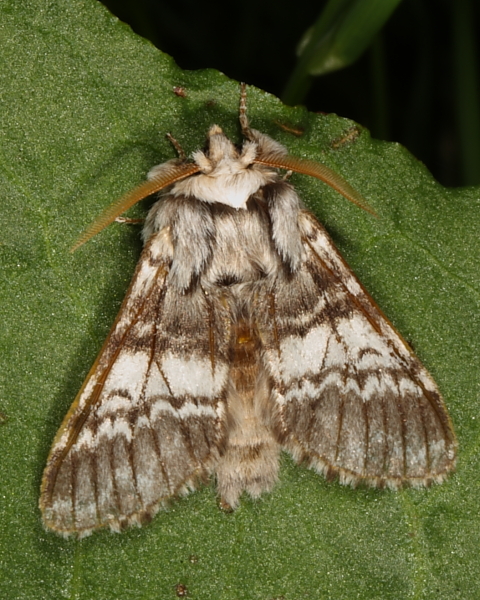
Wednesday 8th May [Sunny spells, rain in the afternoon]
I had a quick look over the lake on the way back from Chew Magna this morning, but didn't see anything worthy of note and, predictably enough, when I went back this afternoon armed with cameras and invertebrate catching gear, it started raining as soon as I got out of the car! So, I went to the hide and sat there for half an hour looking through the Barn Swallows Hirundo rustica, just in case a Red-rumped had dropped in. No such luck, of course! I did eventually spot the ♀ Common Goldeneye Bucephala clangula at Top End and a Common Sandpiper Actitis hypoleucos in the gloom this evening when I went down to do a little bat monitoring.
The contractors were back working on the Bat House this afternoon, after a hiatus caused by other work, and I'm hoping they can complete their work soon because we are well into the season now. It's looking good though. I went down with the new EM3+ this evening and walked between the dam and the Lodge listening to hear what bats were on the wing. I heard Soprano Pipistrellus pygmaeus, Common Pipistrellus pipistrellus and Nathusius's Pipistrelles Pipistrellus nathusii, Myotis spp. and Noctule/Serotines. I thought I'd record some echolocation calls but my batteries ran out (I hadn't charged them on receipt). I think I'll set up some transect walks with Daniel's help.
This evening I heard from Joanna Dailey at Kielder Water about Osprey white 'YA' as follows: "We've had problems with the link to the nestcam recently but from field monitoring we're sure the female is on eggs. Probably last Friday or even Saturday was the first, so hatching about 10 June. I'm 99% certain I saw YA hunting recently, that missing tail feather is a big help for watchers!" See http://kielderospreys.wordpress.com/2013/05/08/nest-1-update-great-news/.
Thursday 9th May [Windy. Sunny spells turning to rain.]
A lunchtime visit to catch some hoverflies, during the sunny spells saw a 'comic' tern at Top End, but I only had my binoculars and saw it briefly behind trees while looking for invertebrates. I did hear a Lesser Whitethroat Sylvia curucca singing at Top End and saw a Speckled Wood Pararge aegeria at Indian Country in the shelter of the pine belt. The water level is 96% according to the Bristol Water website.
I found some sheltered areas and caught a few hovers, including new ones. Here's the list:
- Rhingia campestris lots, none caught
- Eristalis spp. lots, none caught
- Leucozona lucorum ♀
- Helophilus pendulus ♂
- Episyrphus balteatus ♀
- Epistrophe eligans ♂
- Neoascia podagrica [first site record] ♂♀
- Meliscaeva cinctella [first site record] ♂
- Platycheirus peltatus [first site record] ♂
- Melanostoma scalare ♂
- Melanostoma mellinum ♂
This evening I saw 2 Common Terns Sterna hirundo at Top End, one of which was presumably the bird I saw earlier. As dusk fell, they were feeding in front of the Lodge, where a Common Sandpiper Actitis hypoleucos was on the concrete cill. The ♀ Common Goldeneye Bucephala clangula was at Top End and there were hundreds of hirundines (including lots of House Martins Delichon urbicum) and Common Swifts Apus apus all over the lake. It was cold and very windy as it got dark, but at least the rain stopped so I walked for an hour with the bat detector and recorded Common Pipistrellus pipistrellus and Soprano Pipistrelles Pipistrellus pygmaeus using the avenue of trees at the bottom of Park Lane by the Inspection House and Soprano's flying around the clearings in Lodge Copse. There was very little activity away from trees unsurprisingly, and no Noctule/Serotine calls. I recorded zero-crossing and wav files so there may be more information to be discovered when I analyse them all. I certainly thought Lesser Horseshoe Bats were echolocating near the Inspection House, judging by the screen view.
Friday 10th May [Sunny spells]
It was blowing a gale last night and still windy this morning but there was no sign of any storm-driven birds. The ♀ Common Goldeneye Bucephala clangula was at Top End bouncing around in the waves and this evening I saw a Common Tern Sterna hirundo from the hide feeding in the steady rain. I noticed some Cheilosia sp. hoverflies on buttercups at lunchtime behind the Top End hide so took one, which turned out to be:
- Cheilosia albitarsis ♂
I have converted the .wav files recorded on my bat detector last night and, as I suspected, there were some recordings of Lesser Horseshoe Bats Rhinolophus hipposideros near the Inspection House. We are planning, subject to weather, a Nathusius's Bat Survey tomorrow evening, to which interested parties would be welcome. If we catch any, Daniel will probably attach a radio transmitter (assuming the bat is of sufficient weight) to enable the team to track it over succeeding days. I'll post the meeting time and place as soon as I know it. Why not come along and find out more about the project?
Toddy Cooper sent me his spider list from the Somerset Invertebrates Group visit on the 24th April as follows: 'It was a bit early for most of the spiders, but these are the ones that I found. In the wood by Bell's Bush barrier: Metellina mengei ♂♀, Neriene peltata ♀. In the wee huttie: Lepthyphantes minutus ♀. Running around in the grass at Flower Corner: Pardosa amentata and Pardosa hortensis ♂♀ of both spp. Under a log in the Scots pines at Indian Country: Tenuiphantes mengei, a ♀ on egg cocoon. In the grass: Pardosa amentata ♂♀. All of these are common and widespread. No Ospreys !!!!!!!!!!!!'
Saturday 11th May [Windy, sunny spells and showers]
Sean Davies texted to say he'd seen a White Wagtail Motacilla alba alba on the dam that Roy Curber and I also saw during the WeBS Count this morning. There were 2 Common Sandpipers Actitis hypoleucos along the stones at Butcombe Bay and the ♀ Common Goldeneye Bucephala clangula was at Top End. It's very quiet now, and the birds are getting on with nesting. Roy and I saw the first Great Crested Grebe Podiceps cristatus nest today, but I suspect it'll be destroyed by waves this afternoon, in the windy conditions. The gull count was difficult because Lesser Back-backed Larus fuscus and Herring Gulls Larus argentatus are continually coming in to bathe from the fields and flying off again. However, the main surprise was the 9 Great Black-backed Gulls Larus marinus at Peg's Point, and the first Yellow-legged Gull Larus michahellis of 2013 (probably a 2nd-year bird). As I went down for the bat survey in the evening 2 Common Shelducks Tadorna tadorna flew west over the dam.
We had a magical batting session, and at long last caught a ♀ Nathusius's Pipistrelle Pipistrellus nathusii which Daniel fitted with a radio transmitter. I also photographed the wing membrane of one of the males to show the diagnostic veination of the species that I've placed in the species account. When we finished the trapping session, Daniel, Chris and I set off with radio trackers to find out where she was feeding and, hopefully, roosting. I left at 0300 hrs when she appeared to be stationary at a location in Nempnett Thrubwell, 1.75 km from where we trapped and released her. We will check again tomorrow, during the day, to see if she is actually roosting there. Then we'll have the job of radio tracking each night until the transmitter fails or drops off as we try and build up a picture of where she is living and foraging, as well as any interactions she might be having with other bats. More info on the Bat News page where I will post updates about 'Natalie' the radio-tagged Nathusius in the coming week.
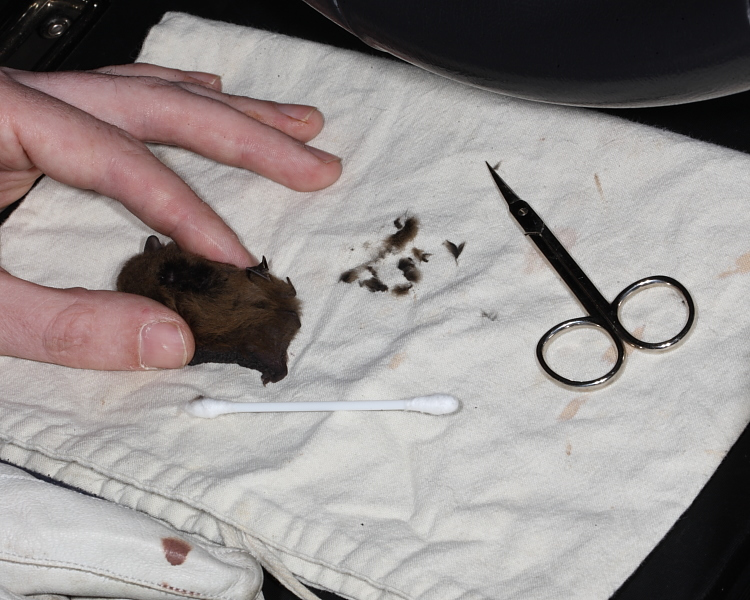
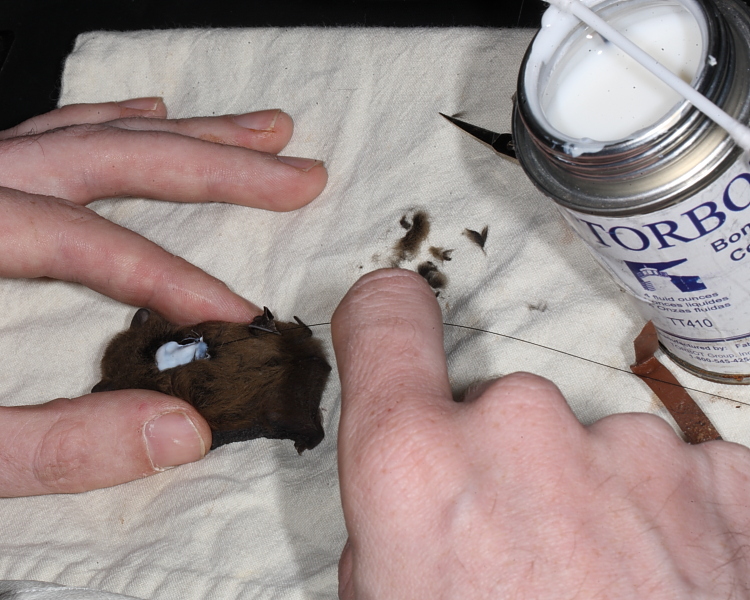
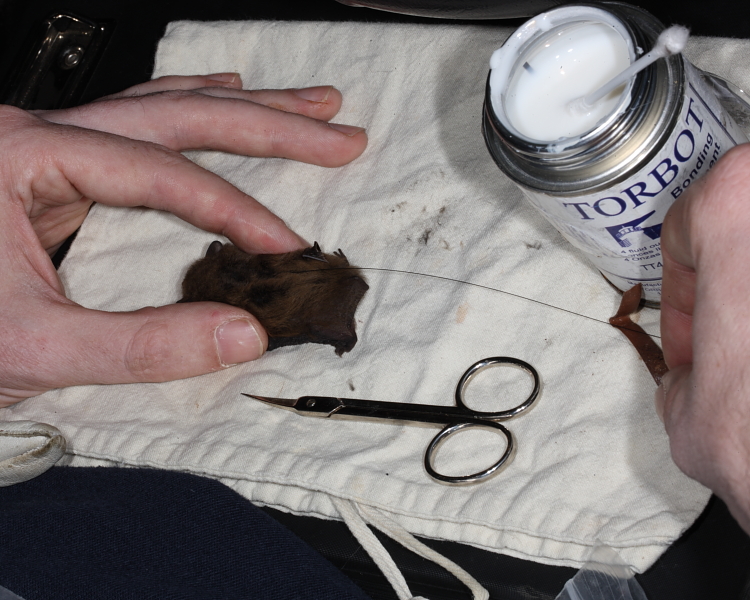
We ran 2 nets (one with a lure that caught the first, and long-awaited, female Nathusius's Pipistrelle), the triple high net and 2 harp traps with lures beside the public footpath and caught:
- Soprano Pipistrelle Pipistrellus pygmaeus 4♂ 13♀ and one not sexed
- Common Pipistrelle Pipistrellus pipistrellus ♂
- Nathusius's Pipistrelle Pipistrellus nathusii 2♂ 1♀
- Daubenton's Myotis daubentonii ♀
- Lesser Horseshoe Rhinolophus hipposideros ♀
- Noctule Nyctalus noctula ♂
I ran my 15W Heath Trap for moths and EM3+ bat detector at Butcombe Bank car park throughout the batting session. Unfortunately, I caught no moths, just one hoverfly to be identified, and recorded over a thousand other bat files that were mainly Soprano Pipistrelles, with some calls from both other pip species. Signing off at 0345 hrs.
Sunday 12th May [A bit grey and damp]
Having been out most of last night 'batting' I wasn't back at the lake until mid-afternoon. This was to check Natalie the Nathusius' radio tag was still transmitting okay with Daniel. A Eurasian Hobby Falco subbuteo flew up the spillway and out over the dam end towards sunset and I'm happy to report the Great Crested Grebe Podiceps cristatus is still sitting on her rocking and rolling nest this evening.
Daniel radio-tracking 'Natalie' the female Nathusius' Pipistrelle. 12th May 2013.
Six of us braved the horizontal drizzle and gale force wind to track Natalie this evening until midnight.
Monday 13th May
On the birding front I received two emails from Robert Billingsley and Paul Williams to tell me that a 1st-summer Little Gull Hydrocoloeus minutus had dropped in and that the ♀ Common Goldeneye Bucephala clangula was at Top End. Thanks guys.
I was away all day walking 18 miles of the South West Coast Path and got back just in time to grab some food and get out to track 'Natalie' the Nathusius's Pipistrelle Pipistrellus nathusii with Daniel until midnight, when I left him to it! He packed up ta 0140 hrs. The walk was from South Haven Point to Renscombe car park at Worth Matravers (said to be 15.1 miles, but 17.66 according to my Garmin Montana GPS). We saw Rnig-necked Parakeet at Studland, two pods of Bottlenose Dolphins off Durlston Country Park and Early Spider Orchids (Dorset Wildlife Trust emblem) at Dancing Ledge and Blackers Hole. The scenery was wonderful, the walk challenging around St Aldhelms Head, and the terrific headwind tiring!
Tuesday 14th May [Steady rain]
There are 2 Common Sandpipers Actitis hypoleucos on the dam this afternoon and thousands of hirundines and Common Swifts Apus apus feeding over the lake in the steady rain. It was miserable out there, and I'm looking forward (not) to radio-tracking 'Natalie' the Nathusius tonight! Hopefully, she won't leave her roost, though with the wind veering to the north east, it'll be interesting to see if she changes her foraging strategy.
This afternoon, David Cottle emailed this article by former 'keeper' at Blagdon Lake, Donald Carr, in the 1934 Annual Report of Wells Natural History & Archaelogical Society.
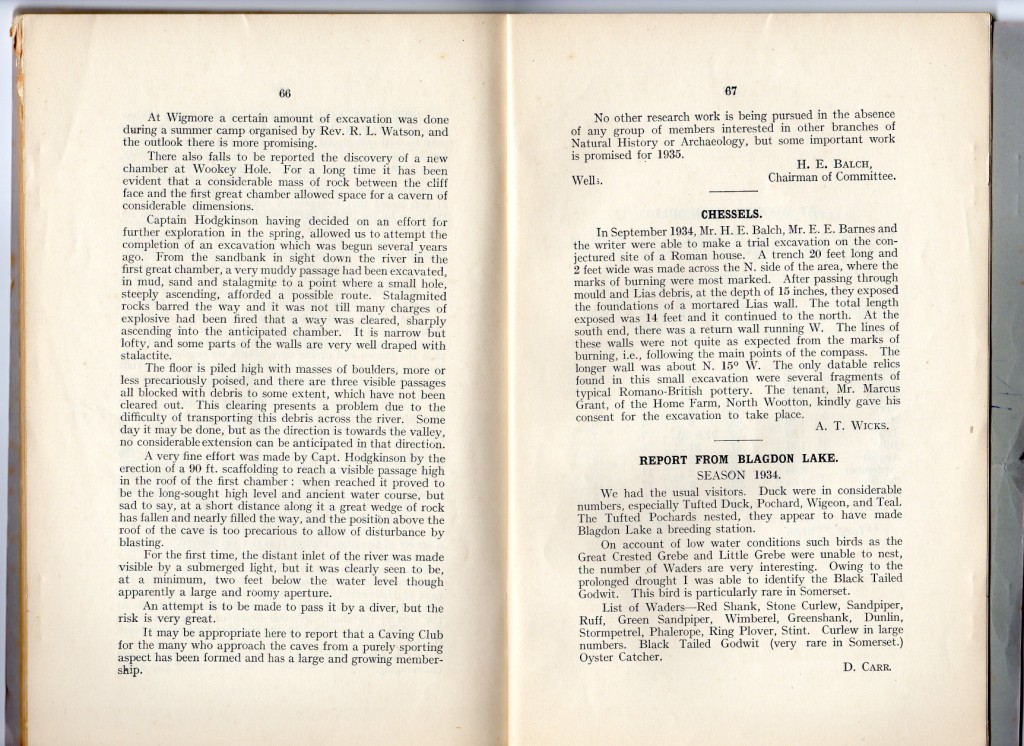
What is particularly exciting, is the mention of Stone Curlew Burhinus oedicnemus. This is a new species for Blagdon and doesn't appear to be mentioned in Palmer and Ballance (1968). I will need to find out if there was any assessment of records in those days, but I can't see why it shouldn't be accepted. The European Storm Petrel Hydrobates pelagicus record is also an earliest date (there have been two subsequently) and my records don't show any Grey (Red) Phalarope Phalaropus fulicarius records for 1934, which is interesting, so I wonder if the 1934 report was missed during earlier research? I'm also struck by the comment about "large numbers" of Eurasian Curlews Numenius arquata being seen - I wonder if they were local breeders?
Rebecca Dobbins, a volunteer at a youth program that hosts activities for local kids (in the USA, I think) contacted me to say that now that it is getting warmer outside, they wanted to find some different outdoor activities to do with the kids. She had been using the website as a resource for their Enriching Kids programme, which is a thrill for me, and that a girl in her group, Madelyn, had found a great resource called A Guide to Finding Local Birds that she wanted to share with us all. I've had a look, and although primarliy aimed at American birders (many of whom I've enjoyed birding with over the years), the basic information contained is sound and worthy of repetition. So, thanks for pointing it out Madelyn, and I hope you enjoy finding some of your local birds.
Wednesday 15th May [Sunny spells]
I haven't been able to spend any time at the lake other than a drive-through check on the way home after having a tooth taken out. I didn't see anything of note other than hundreds of hirundines and Common Swifts Apus apus over the lake and meadows. I'm hoping to get out this evening to radio-track 'Natalie' the Nathusius again and will update Natalie's Diary, if I do. The weather looks more promising at least.
When I went back out I was pleased to see a family of Canada Geese Branta canadensis that included 3 goslings at Peg's Point. I had noted a bird at a nest site with an egg on 12th April that wasn't being incubated at the time. These are the first young birds I've seen this year at the lake , though BW fisheries ranger Laurence told me he'd seen a family of Mallards Anas platyrhynchos on North Shore last week.
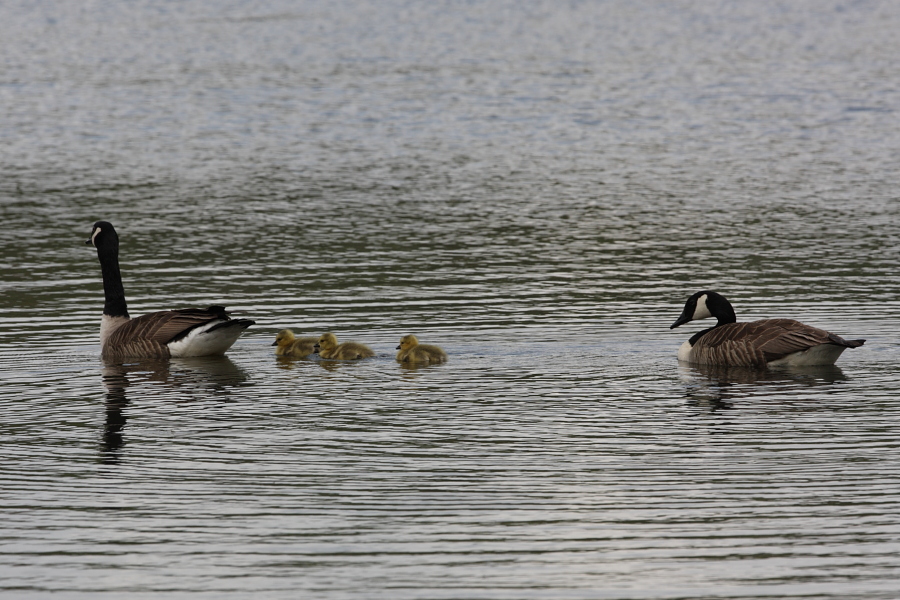
Thursday 16th May [Sunny spells]
There was a 1st-year Great Black-backed Gull Larus marinus on a buoy at the dam end this afternoon which had a dark green darvic ring on its right leg and metal ring on its left leg. The code was 'L42' which makes it a bird that was ringed in Low Normandy, France, by Groupe Ornithologique Normand. I've sent the sighting to them and await a reply. The 3 Canada Goose Branta canadensis goslings are all still alive and were at Wood Bay Point this afternoon - a marginally safer place than Peg's, where they were last night, which is a spot regularly used by loafing Great Black-backed Gulls! I also saw the ♀ Common Goldeneye Bucephala clangula at Top End again. As I walked out of the hide, I spotted the hoverfly Baccha elongata on a Dandelion Taraxacum offinale agg. flower and heard a Lesser Whitehroat Sylvia curruca singing in a hedge nearby.
I took some pictures inside the new Bat House to show how Bristol Water have transformed it into a, we hope, des res!
Ken Anstey, Daniel and I radio-tracked 'Natalie' the Nathusius again tonight. She didn't stay out for long as the temperature dropped to 4 Celsius under a clear sky. She also caused us some confusion that we'll need to try and resolve tomorrow - see diary.
Friday 17th May [Sunny spells with a couple of showers]
I did my BTO BBS square, ST5159, beside the lake this morning, but didn't see anything unusual other than a pair of Common Pochards Aythya ferina off Green Lawn and 4 Gadwall Anas strepera (3 ♂♂ ) in display flight. There was a recently fledged Blackbird Turdus merula at Lodge Copse and a young Song Thrush Turdus philomelos at Holt Copse, so some birds have bred successfully already. Mervyn Pearce dropped by today and told me he'd seen a Spotted Flycatcher Muscicapa striata behind the Top End hide this afternoon.
'Natalie' the Nathusius gave us the big run around this evening, and did something quite unexpected - see Natalie's Diary.
Saturday 18th May [Sunny]
This evening I spotted my first ♀ Mallard Anas platyrhynchos brood, with just a single juvenile in this instance at Long Bay (2nd brood at the lake, 2013).
The Nathusius's Pipistrelle Survey involved us doing some trapping at Rugmoor Bay and Indian Country this evening. We ran a triple high and 3 nets plus a harp trap with lure. On a still evening, we had a good session. Details of the catch were:
- Soprano Pipistrelle Pipistrellus pygmaeus 7♂ 16♀
- Common Pipistrelle Pipistrellus pipistrellus 2♀
- Nathusius's Pipistrelle Pipistrellus nathusii 2♀
- Natterer's Bat Myotis nattereri ♀
- Lesser Horseshoe Rhinolophus hipposideros (recorded on my bat detector)
Ken Anstey and I also radio-tracked Natalie (see Natalie's Diary).
I went to Brean Down for a Somerset Invertebrates Group field meeting during the day. It was a bit windy, but at least the sun was out. I couldn't find much at the fort end of the down but did find a gully with Alexanders Smyrnium olusatrum growing in it that was good for bees and hoverflies. Tony Taylor from Gloucestershire Invertebrates Group and I spent the afternoon looking through it. White Rock-rose Helianthemum apenninum was also flowering profusely along the southern side of the hill.
Sunday 19th May [Sunny and warm]
The ♀ Common Goldeneye Bucephala clangula remains at Top End and I'm sad to report that the Canada Goose Branta canadensis brood is down to 2 goslings now. I saw my first teneral damselfly ot the year this afternoon at Rugmoor Gate. Later, while we were bat trapping, I heard Whimbrel Numenius phaeopus flying over calling on at least three occasions, which takes the site bird list up to 120 spp. for the year.
During a check of a few bat boxes in the afternoon, we found 8 Soprano Pipistrelles Pipistrellus pygmaeus at Indian Country and 20 Natterer's Bats Myotis nattereri in a pre-maternity roost at the Pumping Station, one of which Daniel showed to some people enjoying the Woodland Walk in the sunshine at the Visitor Centre. Most of the Natterer's had been previously ringed by Daniel.
In the evening we had a final bat trapping session with the Glasgow students, who were fantastic, at Ash Tree. What an evening it was too! We caught a Brandt's Bat Myotis brandtii, a first for the site, and had 30 pipistrelles in the harp trap at one point! The evening produced the following totals:
- Soprano Pipistrelle Pipistrellus pygmaeus 1♂ 35♀
- Common Pipistrelle Pipistrellus pipistrellus 5♀
- Nathusius's Pipistrelle Pipistrellus nathusii 2♂
- Noctule Bat Nyctalus noctula ♂
- Brandt's Bat Myotis brandtii [first site record] ♀(parous)
- Daubenton's Bat Myotis daubentonii ♀(parous)
- Lesser Horseshoe Rhinolophus hipposideros (recorded on my bat detector)
Natalie the Nathusius spent some, but not all, of the evening at Chew Valley Lake again in the still conditions.
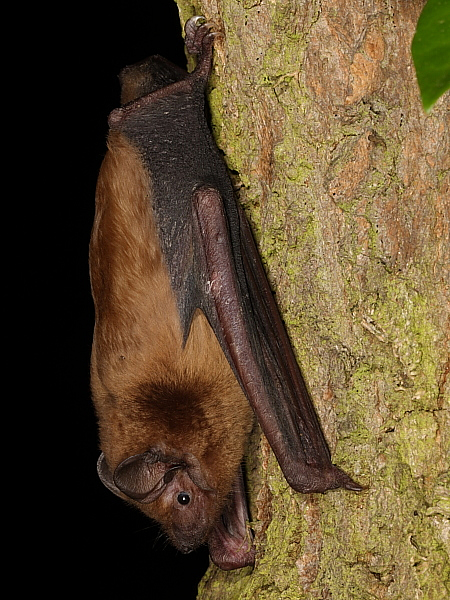
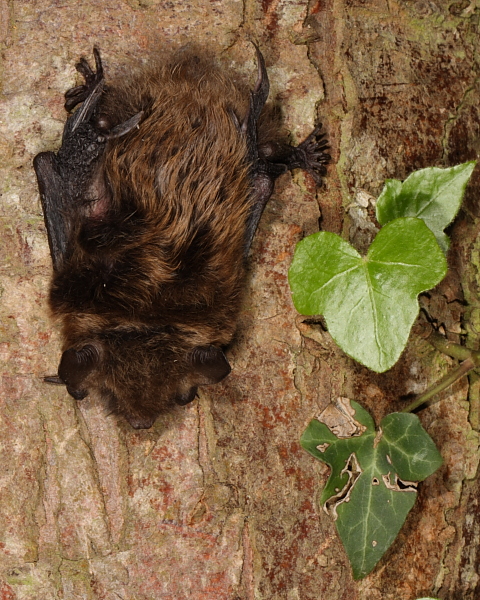
Monday 20th May [Mainly overcast and warm]
I did not get down to the lake until early evening and came across a curious call that I could not put a name to. So, I took some video footage on my Panasonic Lumix to get the sound recorded. As yet I have not been able to put a name to the culprit. I didn't manage to do any other birding before dark as a result.
Fabrice Gallien of the Groupe Ornithologique Normand has replied to my sighting of the 1st-year Great Black-backed Gull Larus marinus at Blagdon on 16th May to say that it was ringed at Chausey, Manche, Normandie on 21st June 2012. It has been reported on one occasion in Weymouth on 10th April 2013.
I checked out Natalie the Nathusius this evening who, when she came out of her alternative roost site, made off for Chew Valley Lake.
Tuesday 21st May [Overcast]
I didn't hear the odd (bird?) call again at dusk, or, after dark yesterday. I also listened for it again at lunchtime and this evening without luck. The ♀ Common Goldeneye Bucephala clangula was at Top End. The radio tag on Natalie the Nathusius was still going strong and she was back from last nights feeding foray at Chew at her roost area.
I saw the pair of Canada Geese Branta canadensis with their 2 goslings again this evening and radio-tracked Natalie the Nathusius out of her roost.
Wednesday 22nd May [Overcast then sunny]
It's still very quiet at the lake, with the ♀ Common Goldeneye Bucephala clangula at Top End and a Eurasian Hobby Falco subbuteo reported there by Mervyn Pearce during the late afternoon. We've had a small influx of non-breeding Canada Geese Branta canadensis with 11 on the fields as well as the usual pair and singleton at Green Lawn. I didn't see the family, but they may have been on the North Shore.
I spent a very interesting and profitable afternoon in Wells Museum in the good company of David Cottle going through the archive of the Wells Natural History and Archaelogical Society and the (from 1907 onwards) Mendip Nature Research Club. In the reports, I found two 'Lists of the Birds Found in the Neighbourhood of Blagdon Lake' produced by Donald Carr (the Keeper) in 1907 and 1908. They and all their subsequent additions make fascinating reading and will allow me to revise the site Bird List to incorporate quite a few new species. One or two are, I have to say, doubtful to say the least but I will add them all, suitably annotated, over the coming weeks. There is a great deal of good information that will add interest to my Blagdon Lake talk, so I won't publish everything here just yet. By the end of the year I will have spoken to many of the local natural history societies (but not the BOC or SOS yet - hint, hint), so will share more afterwards.
Natalie the Nathusius still has her radio tag which continues to emit a clear signal. Latest updates at Natalie's Diary.
Thursday 23rd May [Raw, with hail and rain showers]
The ♀ Common Goldeneye Bucephala clangula has moved back to the dam end and was asleep off the wall late morning. Canada Geese Branta canadensis numbers have increased to 16 (excluding the family). In the evening nothing much had changed, it was still perishingly cold. I forgot to write that I'd found a second dead Grass Snake Natrix natrix on the south side road this morning (another adult). I suspect they are coming out onto the road to try and warm up, then get run over. It was amazing to watch the hirundines and Common Swifts Apus apus continue feeding in the heavy hail storm when I arrived in the morning.
I spent two and a half hours with the radio tracking gear to find out what Natalie did this evening with the change in the weather (see Natalie's Diary).
Friday 24th May [Windy and overcast]
I spent most of the day working on the duck section of the Avon Bird Report, and adding the information below. After tea I got down to the lake and found the ♀ Common Goldeneye Bucephala clangula at Top End, a second Mute Swan Cygnus olor nest, 19 Canada Geese Branta canadensis (but no sign of the family) and 5 Gadwall Anas strepera (a pair that flew into Rugmoor Bay and 3 ♂♂ at Paradise).
It's worth reporting the launch of a landmark document called 'The State of Nature Report' by Sir David Attenborough at the Natural History Museum. The top line is that "working side-by-side, 25 wildlife organisations have compiled a stock take of all our native wildlife. The report reveals that 60 per cent of the species studied have declined over recent decades. More than one in ten of all the species assessed are under threat of disappearing from our shores altogether." However, it does go on to say that it is not all doom and gloom, there are some success stories. The link above is to the RSPB page that includes a link to the report, which says "what we do know about the state of the UK's nature is often based upon the efforts of thousands of dedicated volunteer enthusiasts who contribute their time and expertise to monitoring schemes and species recording." That's why I'm passionate about 'my patch' (a Site of Special Scientific Interest), and am trying to find out as much as I can about it now so we can plan and conserve what we've got (or, rather, what Bristol Water have got). I have included an annotated 1907 Blagdon Bird List compiled by Donald Carr, and just a glance through it will show that we have had many significant changes to our avifauna at the lake in the intervening period. The original document is to be found in the 1907 Report of the Wells Natural History and Archaeological Society, pps. 10-13 of the Mendip Nature Research Club report.
Saturday 25th May [Warm sunshine]
The ♀ Common Goldeneye Bucephala clangula was at Top End, and non-breeding Mute Swans Cygnus olor were trying to drop in but are getting a hard time from the locals. I counted 21 in total today, including two sitting on nests. I saw the family party of Canada Geese Branta canadensis at Peg's Point and the Mallard Anas platyrhynchos brood of 4 well-grown ducklings (1st brood reported by Laurence, the Bristol Water ranger, previously). There weren't too many flying insects of interest after the cold spell. I did, however, catch a ♀ Cheilosia lasiopa, which is new to me and the site. Sean Davies and Mervyn Pearce both reported a single Common Sandpiper Actitis hypoleucos.
This evening we met on the dam at 2000 hrs for the third and final Nathusius's Pipistrelle Survey session of the Spring. We trapped using two nets and two harp traps at Butcombe Bay. As the ♀ bats will be retiring to maternity roosts to give birth and wean their young during June and July, all trapping activity will stop. The young take four to six weeks, on average, to become independent so the survey work will continue in August. Daniel is hoping to host a European Nathusius's Pipistrelle Bat Conference locally, featuring the survey work carried out at Blagdon, with an evening of extensive trapping at Blagdon and Chew for delegates afterwards. We are currently in discussion with Bristol Water about hosting this prestigious event.
The bat session wasn't that good this evening, largely due to the bright moon - which was, however, absolutely breathtaking when it came up over Spinney Point. We caught the following:
- Lesser Horseshoe Rhinolophus hipposideros 3♀ (all parous, with false nipples)
- Serotine Bat Eptesicus serotinus ♀
- Daubenton's Bat Myotis daubentonii ♀
- Soprano Pipistrelle Pipistrellus pygmaeus 8♀
I've posted pictures of the Lesser Horseshoe and Serotine Bats below. I also had the good fortune to spot an Otter Lutra lutra swimming out of Butcombe Bay towards the dam.
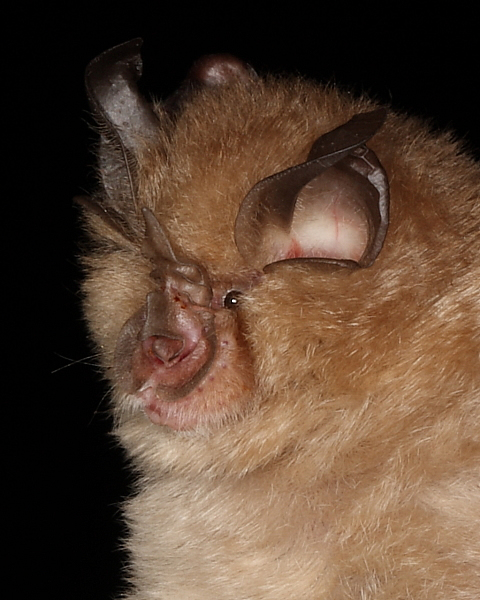
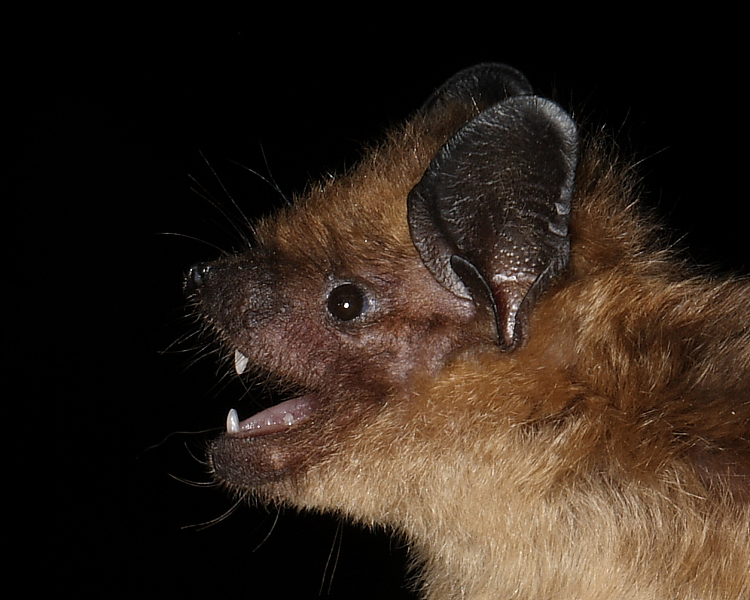
Sunday 26th May [Warm sunshine]
This evening I saw a 3rd brood of Mallards Anas platyrhynchos in Rugmoor Bay and Ian White sent me an email to tell me he'd seen a pair of Spotted Flycatchers Muscicapa striata today.
I've provisionally analysed my bat detector recordings from last night and can add Nathusius's Pipistrelle Pipistrellus nathusii and Noctule Nyctalus noctula, which we didn't catch. I have also added the final report to Natalie's Diary.
Monday 27th May [Overcast with some sunny spells]
This evening I saw a Little Egret Egretta garzetta ranging from Top End to Rugmoor Point and back, 3 Common Pochards Aythya ferina (2♂♂) at Burmah Road and 29 non-breeding Canada Geese Branta canadensis on Holt Farm.
We had a Somerset Invertebrates Group field meeting at Berrow Dunes LNR today and it was lovely to hear a ♂ Common Cuckoo Cuculus canorus singing throughout. I haven't heard one at Blagdon this year.
Tuesday 28th May [Rain all day]
I wrote nothing in my notebook today other than that I'd released a Common Swift Apus apus that an angler friend had inadvertently hooked while fly fishing. It was rather wet and bedraggled, but after drying it off and warming it on my outstretched hand for quite a while it took off and flew out over the lake to join the thousands of other hirundines and Swifts. They can be difficult to get airborne because they cannot take off from the ground, so require sufficient height and clearance to be able to flap their long wings in order to get away. Their little legs are okay for gripping a vertical wall, or similar, but don't have any spring to launch themselves. I didn't see the ♀ Common Goldeneye today or yesterday. It's been absolutely miserable weather today, so it wasn't even worth looking for invertebrates or photographing plants.
My friends and I are planning to walk from Worth Matravers to West Lulworth in Dorset tomorrow, our second leg of the South West Coast Path National Trail. So, I won't be putting out any news from the lake, unless I get down there in the evening. Any news from other observers will be gratefully received.
Wednesday 29th May
Now't to report from the lake I'm afraid. Just back from 16 (due to an official detour) tiring miles along the Dorset coast, although the sunshine made it very pleasant and some of the views were truly stunning. Best bird was a noisy ♀ Peregrine Falcon Falco peregrinus.
Thursday 30th May [Warm with sunny intervals]
We still have Gadwall Anas strepera hanging around at the lake, so I wonder if we'll have a breeding attempt this year? It's not unprecedented, but I don't recall seeing a brood since 2003. Today, I saw the first Mute Swan Cygnus olor brood of the year, a pair with 7 juveniles at Burmah Road, as well the first young Common Coots Fulica atra at Top End. A 4th brood of Mallard Anas platyrhynchos was also at Top End, a ♀ with 9 juveniles. In this mixed up Spring, I noted a ♂ Orange-tip Anthocharis cardamines butterfly still on the wing and my first Small White Pieris rapae.
I've just come across an interesting article on the BBC website about a new fossil discovery in Liaoning Province, China. The creature, named Aurornis xui, dates back about 160 million years and is considered to be the earliest fossil discovered, so far, in Avian evolution. It seems that we are gtting ever closer to finding out how and when birds evolved.
Friday 31st May [Sunny and warm]
I spent a lovely day beside the lake in the company of some visitors from Minehead today. We saw the Canada Goose Branta canadensis (2 juvs) and Mute Swan Cygnus olor (7 juvs) broods, as well as a sitting Great Crested GrebePodiceps cristatus and several Common Coots Fulica atra (including a nest with 7 eggs). A single ♂ Common Pochard Aythya ferina was noted in Holt Bay.
Much of our time was spent agonising over the Dactylorhiza orchids, which appeared to include Common Spotted D. fuchsii, Heath Spotted D. maculata and Southern Marsh D. praetermissa, as well as a huge hybrid swarm of in-betweenies. Amazingly, there were still some reasonable examples of Green-winged Anacamptis morio and Early Purple Orchis mascula orchids in flower too. I saw a couple of Burnet Companion Euclidia glyphica moths, a Silver Y Autographa gamma and my first Common Blue Butterfly Polyommatus icarus of the year on the wing, as well as a Brimstone Butterfly Gonepteryx rhamni flying along a hedge on the North Shore. There were quite a few ♂ Orange-tips Anthocharis cardamines flying in the sunshine, but I have yet to see a ♀, which is rather odd.